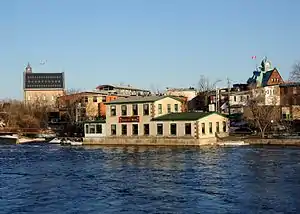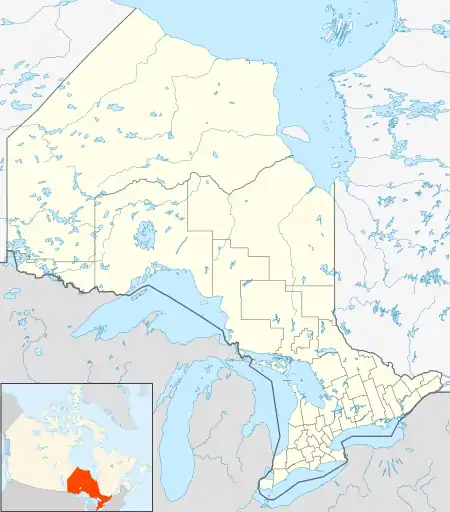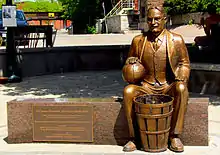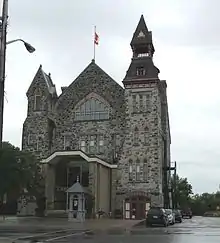Almonte, Ontario
Almonte (pronounced "AL-mont" as opposed to the original Spanish pronunciation of "al-MON-tay") is a former mill town in Lanark County, in the eastern portion of Ontario, Canada. Formerly a separate municipality, Almonte is a ward of the town of Mississippi Mills, which was created on January 1, 1998, by the merging of Almonte with Ramsay and Pakenham townships.[2] Almonte is 46 kilometres (29 mi) south-west of downtown Ottawa. Its population as recorded in the 2016 Canadian Census was 5,039.[1]
Almonte | |
|---|---|
Community | |
 | |
 Almonte Location within Ontario | |
| Coordinates: 45.22629°N 76.19452°W | |
| Country | |
| Province | |
| County | Lanark |
| Area | |
| • Land | 4.41 km2 (1.70 sq mi) |
| Population (2016)[1] | |
| • Total | 5,039 |
| • Density | 1,077.4/km2 (2,790/sq mi) |
| Time zone | EST |
| • Summer (DST) | EDT |
| Postal Code | K0A 1A0 & K0A 4A0 |
| Area code(s) | 613 |
History

First settlers
Almonte's first European-bred settler was David Shepherd, who in 1818 was given 200 acres (0.81 km2) by the Crown to build and operate a mill. The site became known as Shepherd's Falls. That name was never official, however, and Shepherd sold his patent after his mill burned down. The patent's buyer, Daniel Shipman, rebuilt the mill and the settlement became known as Shipman's Mills by about 1821.[3]
Most of Shipman's Mills' early settlers were Scottish and later Irish. A textile town almost from the start, by 1850 it was the home of seven busy woollen mills of Messrs B & W Rosamond. It was one of the leading centres in Canada West for the manufacture of woollen cloth. The construction of a railway line to Brockville stimulated the economic growth of Almonte. During this time of rapid expansion, the town changed its name from Shipman's Mills to Ramsayville, and then to Waterford.
In 1869, Almonte was a village with a population of 2,000 on the Mississippi River in the Township of Ramsay, County of Lanark. It was a station of the Brockville and Ottawa Railway.[4] By the 1870 the town had thirty stores and forty other businesses.[5] Almonte was incorporated as a village in 1871, and was incorporated as a town in 1880.[6]
Origin of the name Almonte
When, in 1855, the newly-created Canadian post office pointed out there was already a Waterford in Canada West, the town needed another name change.[7]
Relations between the United States and Great Britain had been antagonistic since the Revolutionary War and later the War of 1812. Border wars between Mexico and the United States in the 1830s increased this antagonism. Mexican general Juan Almonte had fought honourably in these latter wars, and by 1853 he had become Mexico's ambassador to the United States.
In the ensuing climate of Canadian mistrust of American territorial ambitions, General Almonte's name would have been well known to Waterford's citizens. Though there is no decisive evidence as to the final motive for the name change, it appears likely that Waterford saw Almonte as a "principled David fighting a Goliath interested in swallowing up all North America."[7]
The proposed name change was accepted by the Combined Counties of Lanark and Renfrew in June 1855, although the post office didn't record the new name until 1859.[7] Whenever the name may have been formally accepted, it led to Almonte being the only community in Ontario, and likely Canada, to be named for a Mexican general.[7]
Almonte train wreck, 1942
On December 27, 1942, a troop train rear-ended a passenger train standing in the station at Almonte. Thirty-nine people were killed and more than 150 were injured.[8] The local genealogy page[9] provides photos and a contemporary newspaper report of the wreck.
 The former Almonte Post Office
The former Almonte Post Office.jpg.webp) Almonte train wreck, 1942
Almonte train wreck, 1942 Sculpture of James Naismith
Sculpture of James Naismith
Present day

After the last textile mill closed in the early 1980s, Almonte no longer had a dominant industry. It has since turned its attention towards tourism. It offers museums and several historical spots, such as the home of James Naismith, the inventor of basketball, and the Mississippi Valley Textile Museum.[10]
Almonte retains much of its 19th-century architecture. The former Almonte post office, designed in 1889 by Thomas Fuller (the architect of the Parliament Buildings), and the Rosamond Woollen Mill, the largest 19th-century textile mill in Canada, are both designated as National Historic Sites of Canada.[11][12]
Almonte has a skate park and splash pad which is open to the public and is at the arena.
Events and attractions
Festivals
Almonte is home to several festivals and events, including the North Lanark Highland Games,[13] Naismith 3-on-3 Basketball Festival,[14] Almonte Celtfest[15] and Busfusion.[16]
North Lanark Highland Games
The North Lanark Highland Games[13] have been held annually in Almonte since 1982.
The Games feature traditional Highland sports and entertainment, and bring in about 6,000 visitors each summer.
Almonte Celtfest
The Almonte Celtfest[15] has been held annually in Almonte's Gemmill Park since 1997. The festival's goal is to "celebrate and promote the Celtic heritage of the Ottawa Valley through music and dance."
Schools
Almonte has three elementary schools:
- R. Tait McKenzie Public School[17]
- Naismith Memorial Public School[18]
- Holy Name of Mary Catholic School[19]
Almonte and District High School serves the town of Almonte and much of the surrounding rural area. The Almonte campus of the T.R. Leger School[20] provides adult education and literacy classes.
Mississippi River
The Mississippi River which runs through Almonte has no connection with the U.S. river of the same name.
References
- "Census Profile, 2016 Census: Almonte [Population centre], Ontario and Ontario [Province]". Statistics Canada. Retrieved July 12, 2020.
- County of Lanark website Lanark County: Local Municipalities Archived 2010-08-28 at the Wayback Machine, last retrieved February 14, 2010
- Wheatley, Gerry (February 26, 1992). "David Shepherd was Almonte's first settler". The Almonte Gazette. Almonte. Archived from the original on 2008-12-23.
- The province of Ontario gazetteer and directory. H. McEvoy Editor and Compiler, Toronto : Robertson & Cook, Publishers, 1869
- "Founding of Almonte". Ontario Heritage Trust. Archived from the original on 2012-04-03.
- "Founding of Almonte Historical Plaque". ontarioplaques.com. Retrieved 2020-06-22.
- Cosentino, Frank (2000). Almonte: the life of Juan Nepomuceno Almonte. General Store Publishing. pp. 4–5. ISBN 9780968774601.
- "Troop special plows into local at Almonte", Globe and Mail, December 28, 1942, pg.1
- "The Ottawa Journal". sites.rootsweb.com.
- "Mississippi Valley Textile Museum – museum".
- Former Almonte Post Office. Canadian Register of Historic Places.
- Rosamond Woollen Mill. Canadian Register of Historic Places.
- "North Lanark Highland Games | Scottish culture and heritage of the Ottawa Valley".
- "Naismith Museum And Hall Of Fame". October 25, 2005. Archived from the original on October 25, 2005.
- "Almonte Celtfest – Ottawa Valley and Celtic entertainment".
- "BusFusion". busfusion.com.
- "Welcome to UCDSB Portal". September 24, 2009. Archived from the original on September 24, 2009.
- "Welcome to UCDSB Portal". July 7, 2007. Archived from the original on July 7, 2007.
- "Holy Name of Mary Catholic School – Catholic District School Board of Eastern Ontario – CDSBEO".
- "Almonte campus of the T.R. Leger School".
External links
 Media related to Almonte, Ontario at Wikimedia Commons
Media related to Almonte, Ontario at Wikimedia Commons Almonte, Ontario travel guide from Wikivoyage
Almonte, Ontario travel guide from Wikivoyage- Official website
- Town map, 1863 (JPEG)